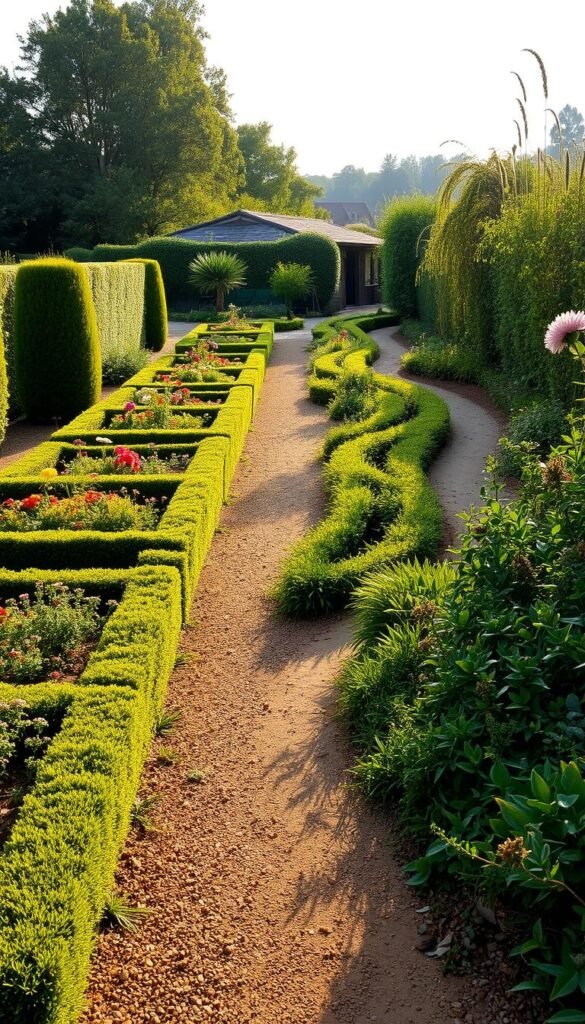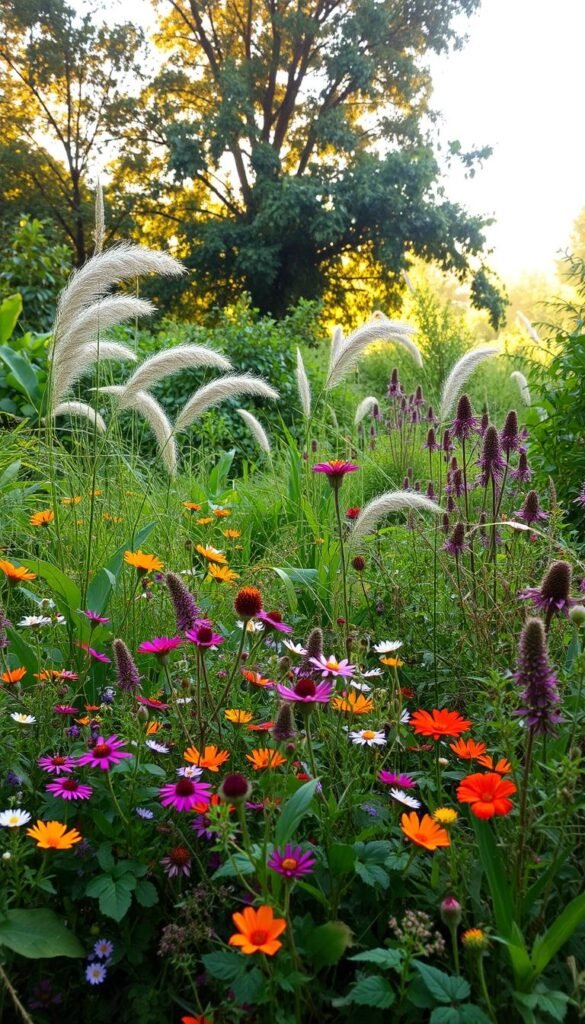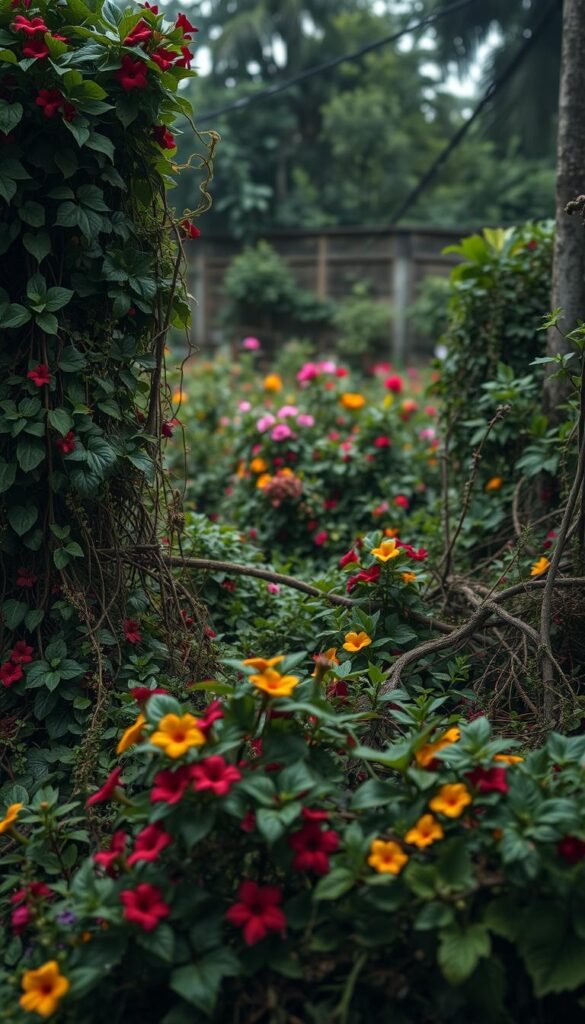Ever scroll through TikTok and stumble upon wildflower explosions or “chaos carrots” sprouting in untamed patches? These viral trends reflect a growing interest in low-effort, nature-driven planting styles that challenge neat rows and rigid beds. Whether you’re tending a balcony or a backyard, understanding these two approaches helps you create a thriving green space.
Traditional gardens prioritize structure: you plan layouts, rotate crops, and prune regularly. It’s ideal if you enjoy predictability or grow veggies needing specific soil conditions. But what if your schedule’s hectic or you want a pollinator-friendly environment? That’s where chaos gardening shines. You scatter seeds in spring, let plants grow where they thrive, and embrace surprises like sunflowers beside herbs.
American gardeners are experimenting with wildflower mixes in vacant lots, while South Londoners blend herbs with ornamental blooms. Both methods have merits. Structured beds offer control, while free-form plantings attract bees and reduce watering. Your choice depends on time, space, and how much “wild” beauty you want. Ready to find your balance? Let’s dig deeper.
Embracing Two Distinct Gardening Philosophies

Imagine stepping into a space where flowers burst through cracks in pavement, and herbs mingle freely with vegetables. This untamed beauty represents one side of modern growing practices. On the flip side, orderly rows of tomatoes and precisely spaced roses showcase decades of horticultural tradition.
Understanding the Appeal of Natural Chaos
This method celebrates surprises. You toss wildflower seeds in spring and let plants thrive where they land. Marigolds might edge your walkway while squash vines claim a sunny corner. Over time, this living mosaic attracts bees and butterflies better than manicured plots.
Why does it work? Nature chooses winners based on soil conditions and sunlight. You save time normally spent weeding or rearranging beds. Plus, diverse plant groupings help prevent soil depletion.
Overview of Traditional Gardening Principles
Structured growing focuses on control. You design layouts to maximize yields and rotate crops yearly. This approach works well for delicate vegetables needing specific pH levels or consistent watering schedules.
| Aspect | Natural Style | Structured Style |
|---|---|---|
| Plant Placement | Random, seed-scattered | Grid-based, measured |
| Maintenance | Minimal pruning | Weekly care |
| Best For | Pollinator habitats | High-yield veggies |
Traditional beds demand more attention but offer predictable results. You’ll know exactly where your carrots grow each summer. Both philosophies can coexist—many gardeners blend them for balanced beauty and productivity.
Chaos Gardening: Origins and Viral Trends

What started as scattered wildflower experiments became a full-blown cultural movement. In December 2023, Pinterest reported a 300% spike in searches for “untamed garden ideas,” signaling a shift toward free-form green spaces. Social media transformed this concept into a global phenomenon, blending nature’s randomness with digital sharing.
How TikTok and Social Media Sparked Interest
TikTok user @MegGrowsPlants accidentally started the “chaos carrot” trend by broadcasting her haphazard seed-tossing method. Her video gained 2.1 million views in a week, inspiring others to try the “throw and grow” approach. Platforms like Instagram amplified the trend, with #ChaosGarden posts showcasing dandelions bursting through pavement cracks and herbs sprouting beside roses.
This style resonates because it’s accessible. You don’t need perfect soil or hours of planning—just a mix of hardy seeds and curiosity. Urban gardeners in Chicago turned vacant lots into floral jungles, while West Yorkshire residents transformed balconies with random seed bombs.
The Evolution from Wildflower Beds to Chaos Carrots
Early adopters planted wildflowers to support pollinators, but the concept grew wilder. Today’s chaos gardens might feature carrots growing beside marigolds or tomatoes tangled with nasturtiums. The key? Letting plants compete naturally for sunlight and water.
| Traditional Wildflower Beds | Modern Chaos Gardens |
|---|---|
| Pre-planned layouts | Random seed scattering |
| Single-season blooms | Year-round surprises |
| Targeted pollinator species | Diverse insect habitats |
This evolution reflects our changing relationship with green spaces. Instead of fighting nature’s quirks, gardeners now celebrate them—one unpredictable sprout at a time.
Chaos Gardening vs. Traditional Methods: Which Suits Your Space?

Your garden’s personality might thrive in structured beds or untamed corners—let’s explore both. Free-form growing works wonders if you love surprises. Toss a wildflower seed mix in spring and watch poppies peek through thyme or cosmos frame your patio. This “let nature decide” approach saves time and water while creating habitats for pollinators.
Structured gardens offer predictability. You control plant placement, ensuring tomatoes get full sun and herbs avoid soggy soil. This method suits those growing delicate veggies or aiming for high yields in small spaces like raised beds.
| Factor | Free-Form Style | Structured Style |
|---|---|---|
| Time Investment | 1-2 hours/month | 4-6 hours/month |
| Aesthetic | Wild, textured | Neat, organized |
| Upkeep | Minimal weeding | Regular pruning |
| Best Fit | Large yards | Balcony boxes |
Consider your available space and schedule. A sprawling backyard could handle rambling squash vines, while a fire escape might need compact basil plants. Both styles improve soil health over time—one through natural composting, the other via crop rotation.
Which sparks more joy? Watching bees dance between untamed blooms or harvesting identical zucchini each July? Your answer shapes your garden’s future. Maybe blend both: design a tidy herb spiral surrounded by a wildflower meadow. Nature loves balance.
Benefits of Adopting a Chaos Gardening Approach

Picture a garden where every corner buzzes with life—bees darting between mismatched blooms, herbs sprouting beside vegetables, and soil teeming with unseen helpers. This vibrant ecosystem thrives when you let nature guide your planting choices. The result? A resilient green space that adapts to challenges while supporting local wildlife.
Fostering Biodiversity and Natural Resilience
Scattering a mix of seeds creates a living tapestry of competing and cooperating plants. Clover might fix nitrogen for nearby kale, while marigolds repel aphids from your tomatoes. This diversity mimics natural ecosystems, making your garden less prone to disease outbreaks. Urban gardeners in Portland, Oregon, report 40% fewer pest issues after switching to wildflower-vegetable blends.
Pollinators adore the variety. A single chaos plot can attract 15+ bee species compared to 3-5 in structured beds. Even “weeds” like dandelions play a role—their deep roots aerate compacted soil.
Reducing Monoculture Vulnerabilities
Monocultures are buffets for pests. Imagine Colorado potato beetles decimating an entire row of spuds. Now picture those same beetles struggling to find potatoes hidden among nasturtiums and onions. Chaos gardening spreads risks like a smart investment portfolio.
Texas gardeners using this approach saw 60% less fungal damage during humid summers. Their secret? Letting basil self-seed between peppers creates natural airflow and disrupts spore spread.
While this style needs minimal maintenance, occasional pruning keeps aggressive plants in check. Water deeply once a week, and let rainfall handle the rest. Your reward? A self-sustaining oasis where beauty and productivity grow wild—together.
Challenges Associated with the Chaos Gardening Method

While free-form planting feels liberating, it’s not without hurdles. Unpredictable growth patterns and tenacious weeds test even the most laid-back gardeners. Let’s explore common obstacles and practical solutions to keep your wild oasis thriving.
Uninvited Guests: Weeds and Aggressive Species
Scattering seeds might accidentally welcome bullies like bindweed or crabgrass. These invaders steal nutrients and space from your chosen plants. One Minnesota gardener found morning glories choking her sunflowers within weeks. “I learned to spot troublemakers early,” she says.
Prevent overgrowth by:
- Mixing native wildflower seeds with vegetables
- Pulling invasive sprouts during weekly check-ins
- Using cardboard mulch in problem areas
Harvest Hiccups and Care Requirements
Your tomato yield might vary wildly compared to structured gardens. Random spacing can lead to crowded roots or shade-starved greens. A Kansas grower reported 30% fewer peppers but triple the basil in her chaos plot.
| Challenge | Chaos Approach | Traditional Fix |
|---|---|---|
| Low Yields | Add compost annually | Fertilize monthly |
| Pest Control | Encourage ladybugs | Apply neem oil |
| Water Needs | Use drought-tolerant plants | Install drip lines |
“Chaos doesn’t mean neglect—it means working with nature’s rhythm.”
Find your balance by observing which plants thrive in your space. Trim overcrowded zones in fall and let hardy species self-seed. With slight adjustments, your untamed paradise can flourish year after year.
Exploring Traditional Gardening Techniques
Have you ever admired perfectly aligned flower beds in botanical gardens? This timeless approach transforms outdoor spaces into living blueprints. Structured designs prioritize predictability, making them ideal if you crave order or grow delicate plants needing precise care.
Structured Planting and Defined Garden Beds
Traditional methods rely on careful planning. You’ll sketch layouts before planting, ensuring each species gets optimal sunlight and nutrients. Raised beds with cedar borders keep roots contained, while stone pathways prevent soil compaction. Chicago’s Garden Conservancy showcases this style with symmetrical herb spirals and color-coordinated annuals.
Why choose defined areas? They simplify maintenance. You’ll water specific zones instead of entire plots and spot pests faster. A Pennsylvania study found structured gardens required 35% less weeding time compared to wilder setups.
| Feature | Traditional Style | Chaos Approach |
|---|---|---|
| Plant Placement | Grid-based design | Random scattering |
| Watering | Targeted irrigation | Rain-dependent |
| Harvest Predictability | 90% consistent yields | 40-70% variance |
Longwood Gardens demonstrates how structured planting creates visual harmony. Their tulip displays use mathematical spacing for ripple effects of color. While this method demands upfront work, it rewards you with Instagram-worthy flowers all season.
Prefer low-maintenance order? Try these tips:
- Use landscape fabric under mulch to suppress weeds
- Group plants with similar water needs
- Edge beds monthly for crisp lines
Traditional techniques shine when you value control over spontaneity. They’re like a favorite recipe—follow the steps, and you’ll savor reliable results year after year.
Deciding Which Gardening Method Fits Your Space
Choosing between wild abandon and orderly rows starts with understanding your unique growing environment. Let’s explore three key factors that’ll help you pick the perfect approach—without second-guessing your green thumb.
Assessing Your Garden’s Size and Soil Conditions
Start by measuring your available area. A 10’x10′ plot can handle structured tomato cages, while sprawling yards might benefit from scattered wildflower seeds. Urban balcony? Try compact herbs in vertical planters paired with trailing nasturtiums.
Test your soil using a $7 kit from garden centers. Acidic earth? Blueberries will thrive. Sandy texture? Opt for drought-resistant lavender. As Oregon State University notes: “Soil health determines 80% of planting success, regardless of style.”
| Space Type | Chaos-Friendly Plants | Structure-Friendly Plants |
|---|---|---|
| Small (under 50 sq ft) | Microgreens, thyme | Dwarf tomatoes, basil |
| Large (100+ sq ft) | Sunflowers, squash | Corn rows, bean trellises |
Considering Your Maintenance and Time Commitments
Be honest: how many hours can you dedicate weekly? Free-form plots need just 15 minutes for monthly seed scattering. Structured beds demand 2-3 hours for pruning and pest checks.
- Low-effort option: Plant native perennials like coneflowers
- High-care choice: Hybrid roses needing weekly feeding
Retired teacher Martha Greene shares: “I blend both styles—neat veggie beds up front, wildflowers out back. Best of both worlds!” Match your energy levels to your garden’s needs, and you’ll avoid burnout.
Still torn? Try a 70/30 split. Designate most space for easy-care plants, reserving a corner for experimental seed mixes. Your perfect balance awaits!
Practical Steps for Implementing Chaos Gardening
Ready to turn your outdoor area into a thriving, low-effort paradise? This hands-on guide walks you through creating a vibrant ecosystem that practically cares for itself. Let’s transform your patch into a living canvas of color and texture.
Preparing Your Garden and Selecting Seeds
Start with a hardy seed mix—native wildflowers, herbs, and veggies like kale or radishes. These plants adapt easily to your local climate. Rake the soil lightly to loosen it, but skip tilling. Nature prefers a bit of roughness for better root grip.
Scatter your seeds like confetti! Aim for 2-3 varieties per square foot. Mix tall sunflowers with creeping thyme for vertical interest. Water gently once, then let rainfall take over. Your garden will decide which sprouts thrive.
Simple Tips for a Low-Maintenance Approach
Mulch with shredded leaves to retain moisture and suppress weeds. Check growth every fortnight—trim aggressive species if they overshadow others. A Seattle gardener shares: “I let nasturtiums sprawl but pull mint runners. It’s about balance, not perfection.”
| Task | Chaos Method | Traditional Method |
|---|---|---|
| Watering | Only during droughts | Weekly schedules |
| Weeding | Remove invasives only | Full-bed clearance |
| Pruning | As needed for light | Monthly shaping |
Notice squash vines overtaking your path? Guide them toward a fence instead of uprooting. Your garden will evolve naturally, revealing unexpected partnerships between plants. By fall, you’ll have a self-sustaining chaos garden that buzzes with life!
Integrating the Best of Both Worlds
What if your garden could offer both curated beauty and wild surprises? Many growers are discovering that blending structured layouts with free-spirited growth creates spaces that delight the eye and support ecosystems. Let’s explore how to marry these styles without compromising their strengths.
Combining Structured Design with Natural Growth
Start by framing wild areas with intentional elements. A stone pathway winding through native flowers keeps foot traffic contained while letting plants spill over edges. Raised beds for tomatoes or herbs can anchor corners, surrounded by self-seeding poppies or cosmos.
Consider these pairing ideas:
- Boxwood hedges bordering wild strawberry patches
- Trellised beans climbing beside sunflowers
- Neat rosemary bushes flanking a chaos garden of mixed lettuces
Examples from Real American Gardens
At North Hill Gardens, designers intersperse formal hydrangea rows with milkweed clusters for monarch butterflies. Meanwhile, a Portland homeowner transformed their yard using this hybrid approach:
| Structured Element | Wild Counterpart |
|---|---|
| Geometric herb spiral | Meadow-style wildflowers |
| Staked pepper plants | Ground-cover thyme |
| Mulched walking paths | Unmown grass islands |
Balance is key. Prune aggressive growers but let hardy plants self-seed. Water structured zones regularly while allowing rain to nourish wild patches. This approach lets you enjoy orderly harvests and nature’s spontaneous artistry.
Wrapping Up Your Garden Journey
Your exploration of growing styles reveals nature’s flexibility. Structured gardens deliver reliable harvests, while untamed plots foster biodiversity through unexpected plant partnerships. Both methods adapt to your soil type and personal rhythm.
Have a small patio? Blend dwarf tomatoes with self-seeding marigolds. Manage a large yard? Let native plants weave between raised beds. Even a “chaos garden” thrives when you notice which species naturally dominate your space.
No rulebook demands perfection. A friend’s orderly hydrangeas and your scattered wildflower seeds both nourish ecosystems. Success lies in balancing control with curiosity.
Stay inspired by swapping gardening tips locally or trying new seed mixes yearly. Each season offers fresh lessons—whether your kale grows in neat rows or beside rogue zinnias. Your green sanctuary evolves with every choice, blooming uniquely under your care.






